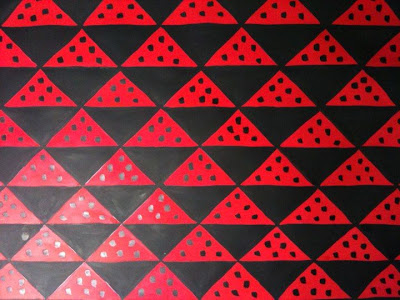Four designers in training came together to produce a final product based on the batik artworks that they’ve created. Each of the artworks were then analyzed. The artworks were analyzed based on their composition, colors, design, inspirations, the personality of the creator or background of the artwork that affected its design, and any other factors that influenced their design. After analyzing each of the artwork, a final product is produced. The final product is inspired by or has incorporated the elements, style, design and colors of the four different artworks.
The pieces of artworks created are batiks. Batik uses wax to create patterns and designs on fabric and color is applied to the fabric using a dyeing method. The wax controls the spreading of colors from a specific area when the dye is painted to create motifs. There are three types of methods of creating batik. One way is using blocks dipped into wax to print the motives and the second method is drawing the designs onto the fabric by hand. A less common method is designing without using wax, which is the tie dye method. This works by twisting the fabric and dyeing it in dye to create circular or twisted patterns. The materials used to make batik are wax, dyes and single spout Tjanting. The process starts by filling the Tjanting with a mixture of wax and resin. The Tjanting is used to draw the patterns on the fabric, which could be either cotton or silk. The fabric is then painted using dyes and left to dry. After that, the wax is removed by soaking the fabric in boiling water mixed with soda for a few minutes. After a last round of drying, the batik artwork is then completed.
“Roses by Sunrise”
The composition of visual elements in the batik is arranged at the four sides of the batik. The main visual element in this batik design is the pink rose at the right side. The reason why the
pink rose is the main element is due to its larger size. This difference in size creates an emphasis on the rose. Green, purple, yellow, orange, red and pink are the main colors in the batik. The colors orange, red and yellow are to make this batik look more cheerful and happy. Purple color is to make the whole batik look more elegant. The middle part of the batik was painted yellow to represent sunlight. All of us cannot live without sunlight, same goes to plants. The yellow painted in the middle of the batik is to emphasize how important sunlight is to life. The traditional batiks in Malaysia are mostly larger floral motifs, light and vibrant in coloring.
Malaysian batik often displays floral to avoid the interpretation of human and animal images as idolatry, in accordance with local Islamic doctrine. Malaysian batik is also famous for its geometrical designs, such as spirals. I chose floral as my theme to stick with the traditional batiks. I combined a few types of floral motifs in my batik to make it more interesting.
The inspiration for this batik design came from the creator’s first visit to Central Market. There, she saw many different types of batik designs and motifs. Among all out them, she liked floral batik designs the most. The simple design with floral prints brings out simple sophistication. The influence of the color choice is the season of summer. Summer brings happiness and joys, the creator wants people who see this batik to feel warm and grateful because summer is the new start of another year and to appreciate what had passed and accept what is coming up next.







.jpg)
.jpg)





















.jpg)
.jpg)
.jpg)
.jpg)
.jpg)
.jpg)
.jpg)

